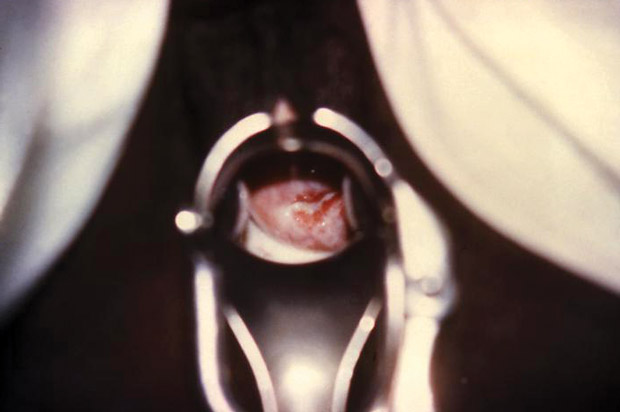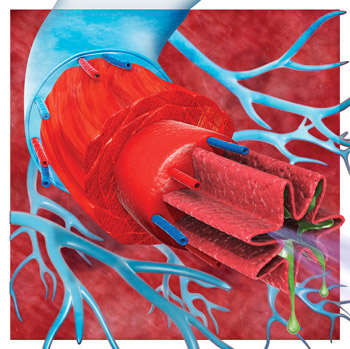MKSAP Quiz: Lower abdominal pain, vaginal discharge
A 26-year-old woman is evaluated in the emergency department for lower abdominal pain with vaginal discharge. She reports no nausea or vomiting but noted vaginal bleeding after intercourse the previous night. She is sexually active, with two partners in the past 3 months, but she does not use condoms consistently. She has an intrauterine device for contraception and takes no medications.

On physical examination, vital signs are normal. Pelvic examination is shown; uterine and cervical motion tenderness are noted, but she has no adnexal tenderness or masses.
A urine pregnancy test is negative. Samples are obtained for nucleic acid amplification testing for Neisseria gonorrhoeae and Chlamydia trachomatis.
Which of the following is the most appropriate empiric treatment?
A. Intramuscular ceftriaxone plus oral doxycycline
B. Intravenous cefoxitin plus oral doxycycline
C. Intravenous clindamycin plus intravenous gentamicin
D. Oral amoxicillin-clavulanate plus oral doxycycline
Answer and critique
The correct answer is A. Intramuscular ceftriaxone plus oral doxycyline. This item is Question 11 in MKSAP 18's Infectious Disease section.
The most appropriate treatment for this patient is a single dose of intramuscular ceftriaxone (250 mg) plus oral doxycycline (100 mg twice daily) for 14 days. The patient has risk factors for sexually transmitted infections (multiple partners and inconsistent condom use) and presents with symptoms suggesting pelvic inflammatory disease (PID). Uterine and cervical motion tenderness are sensitive findings for the diagnosis of PID; the likelihood of PID is further increased by the presence of mucopurulent cervical discharge. Antibiotic therapy should begin before diagnostic testing results are received. Although PID is a polymicrobial infection, testing only for the common sexually transmitted pathogens, Neisseria gonorrhoeae and Chlamydia trachomatis, is recommended. Although a positive result for either pathogen significantly increases the probability of PID, even if the result is negative, a treatment course for PID should be completed based on clinical findings. Women with an intrauterine device can be treated successfully with the device in place in most cases. In addition to the diagnostic testing obtained from the cervical discharge, this patient should be screened for HIV and syphilis.
This patient has no signs of systemic toxicity or findings to suggest a potential surgical emergency, so hospitalization is not indicated. She is not pregnant and has no history suggesting she would be unable to tolerate oral therapy, so ambulatory treatment is appropriate. Intravenous cefoxitin plus doxycycline and intravenous clindamycin plus gentamicin are regimens for inpatient management of PID. Intravenous ampicillin-sulbactam plus doxycycline is an alternate regimen for hospitalized patients; however, oral amoxicillin-clavulanate is not recommended for the treatment of PID.
Key Point
- In patients with a high likelihood of pelvic inflammatory disease without indications for hospitalization, empiric therapy with intramuscular ceftriaxone and oral doxycycline is appropriate without waiting for microbiologic testing results.




